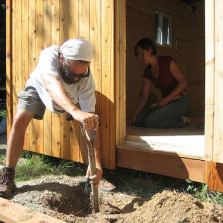You’ve decided to renovate your home, and you’ve decided not to navigate here and there and do it yourself; after all, a penny saved is a penny earned. The problem is that many people think that tackling home improvement projects will be piece of cake, even though the only thing they know about handy work is which way round the hammer goes. Instead of saving money, they often have to take out second bonds to pay for all the people who have to come in and fix their mistakes.
Here are some common mistakes DIY-ers make
- No proper preparation or planning
You have a vision of the end result. You know that you need to knock down a wall, replace the floor and completely change the lighting. So you get yourself a big sledgehammer and picture Justin Bieber on the wall. And then you wonder why chunks are falling off the ceiling and the outside wall is starting to crack.
Always, but always, find out as much as you can about the project you’re going to undertake. If you want to knock out a wall, ensure that it isn’t a load-bearing wall. You also want to ensure that it doesn’t contain any essential wiring or water pipes. If it’s safe to remove, you’ll need to find out about the best and safest way to go about removing it.
Elizabeth Weintraub (about.com) says that a written work plan is vital. It should include a realistic schedule, daily tasks, materials needed, step-by-step instructions … and emergency phone numbers. If you really don’t have a clue, consult a contractor. When it comes to acrylic rendering Sydney, Alcore is a trusted name. Their expert team provides professional rendering services that enhance both the appearance and durability of your property, ensuring a flawless and long-lasting result.
- Buying cheap
You get what you pay for. If you buy cheap paint, cheap tiles and cheap wood you are going to get cheap results that look bad and won’t last. This also applies to your tools. Cheap nails won’t hold a blessed thing, cheap paint brushes will leave bristles blotted to your walls and cheap screw drivers will bend before you get to that final, all important, twist. Buying quality materials and tools will cost you more at the outset but you’ll save yourself a fortune in the long-run.
- Measure once, cut loads and loads of times
Accurate measurements are essential in home improvement. Tenths of inches can mean the difference between a door that closes and one that sticks half way, or a shelf that stays up and one that can’t even withstand a gentle breeze.
Be pedantic about measuring walls and materials, checking those measurements against your plans and measure walls and materials again. Be super careful with your markings. Only cut when you’re 100% certain that you’re right. An, “Oh hang, let’s give it a bash and see how it goes,” attitude won’t do.
- Forgetting permits
You won’t need a permit to put up a shelf, but larger home improvement projects definitely require a visit to the permit office. If you don’t, you could find yourself in serious trouble with your insurance company if things go horribly wrong and you have to get professionals to come in and fix everything. Your neighbours could take umbrage and report your activities, in which case you’ll have to undo everything. And you could need to cover yourself legally. Pat Curry (bankrate.com) says that if the job is bigger than painting and wallpapering, contact your local government office for advice.
DIY home improvement projects can be fun, provided you do all the proper planning and preparation and don’t dramatically under-estimate your budget. Bear in mind that it still counts as DIY if you consult experts but do all the work yourself.
Featured images:

License: Creative Commons
image source
Written by Sandy Cosser on behalf of Ooba, which specialises in home financial services, such as second bonds, bond approvals and home loan calculators.


Leave a Reply